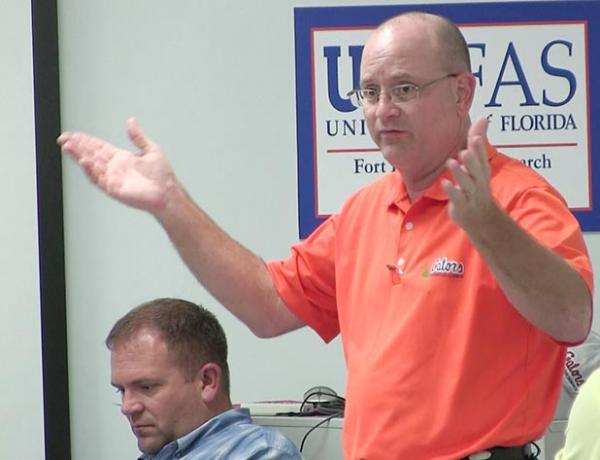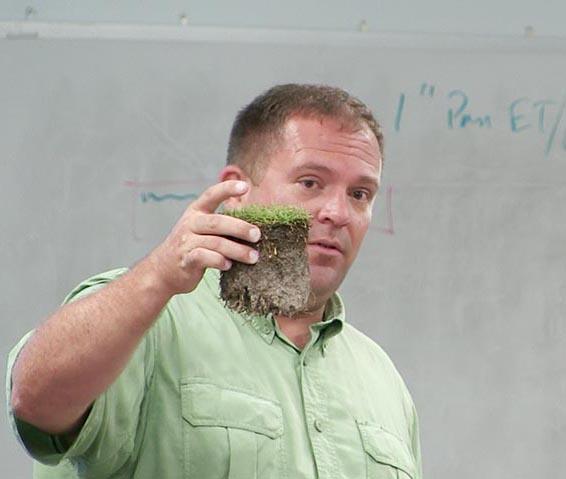To those who believe, as professional turf managers, they already are walking a fine line where irrigation is concerned, scientists at the University of Florida have some news: Chances are, you ain't seen nothing yet.
 "Water is the Achilles heel of the golf industry," said Bryan Unruh, Ph.D., professor of environmental horticulture at UF, during a recent educational event at the university's South Florida Research and Education Center in Fort Lauderdale. "It drives everything."
"Water is the Achilles heel of the golf industry," said Bryan Unruh, Ph.D., professor of environmental horticulture at UF, during a recent educational event at the university's South Florida Research and Education Center in Fort Lauderdale. "It drives everything."One need only look at the message the USGA is sending each year during the U.S. Open for proof.
"We are hoping to change players' perceptions," said USGA executive director Mike Davis during the 2015 U.S. Open at dried-down Chambers Bay in Washington. "For years, we have gone lush and plush. Players like that. They are used to it."
Although golfers like lush and plush, but just about everyone else knows that is an unsustainable model and the pressure to use less and less will only intensify.
Water-saving measures have been in place in Arizona and Nevada for years, and California's drought restrictions that were imposed in 2015 were well publicized. As access to usable water becomes more challenging in the years to come, those who grow finely managed turfgrass will fall under increasing scrutiny in a country where the average non-superintendent uses 80-100 gallons of potable water per day, according the U.S. Geological Survey, to do things like shower, brush their teeth and do laundry.
According to the USGS, there are about 332.5 million cubic miles of water on the planet. The amount of water present on earth has held relatively steady for "eons", said UF assistant professor Jason Kruse, Ph.D. In fact, the amount of water that falls in the form of precipitation outpaces the amount lost to evaporation each year by about 30 percent, representing a potential annual net gain of nearly 9,000 cubic miles, according to the USGS. Clearly, the problem is not availability of water, it's that so much of it is unusable in its current state.
Of that total volume of earth's available water, fresh water comprises only 2.5 million cubic miles. And only half of that is usable, with the rest is frozen atop mountains worldwide.
"We're not losing water," Kruse said during the two-day event for professional turf managers. "What is changing is where that water is located.
"We may never run out of water technically, but we're going to run out of good water. And that is going to increase the cost of water if we have to start desalination plants for drinking and living purposes. Price of water, or an inability to make coffee in the morning are going to affect how we use water in the landscape at some point."
The point UF researchers were illustrating is that there is a difference between availability of water and quality of water.
Kruse pointed to two examples to make his point - his native Idaho and his current home, Florida.
Southern Idaho receives most of its scant 10 or so inches of rain each year in a matter of weeks, not months.
"The aquifer where we pumped water from at the house I lived in was 650 feet down, so by time water made it to that aquifer, it was pretty clean," he said. "The problem was it was being pumped out through so many wells by farms in the area that it was draining quickly. Availability was the concern, not quality."
In Florida, the growing concern is water quality. It is estimated that as many as 1,000 people per day are moving to Florida, and the pressure that growth is placing on the state's system of underground aquifers is leading to saltwater intrusion on some occasions.
"What is reality is we may reach a point where our water use in the landscape is even more heavily scrutinized, which is already happening in places like California," he said.
"Availability of water sets the pace for how we manage a landscape."
 Indeed. The United Nations says that by 2025 1.8 billion people will be living in areas under what it called "absolute water scarcity" and that two-thirds of the population will be living in water-stressed conditions.
Indeed. The United Nations says that by 2025 1.8 billion people will be living in areas under what it called "absolute water scarcity" and that two-thirds of the population will be living in water-stressed conditions.For those same reasons, there is likely to be a push from within the golf industry to convince superintendents of the benefits of irrigating turf based on evapotranspiration. Although some are irrigating that way now, the majority do not.
Unruh suspects superintendents don't irrigate off of ET now because it is a shifting dynamic that changes daily based on factors like humidity, wind and sunlight.
"Uniformity of distribution is all over the place," said David Dore-Smith, superintendent at Copperleaf Golf Club in Bonita Springs, of ET-based irrigation. "I know superintendents who hand-water everything on greens."
The University of Florida recommends irrigating turf based on 70 percent of ET. Anything more that could push nutrients below the root level is wasteful.
"Sandy soils can't hold all that water. It goes right through," Unruh said, likening the soil's ability to consume to that of a greedy teenager.
"What happens when you give a teenager everything they want? They use it all," he said. "Overwatering turf is like giving that teenager everything they want, plus more, they're lazy and not much use."
Finally, water-use analogies in terms we can relate to.

